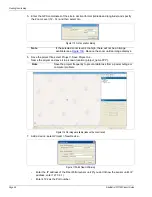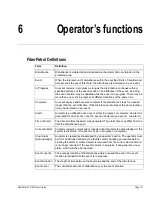
Setting Alarm Detection Parameters
FiberPatrol FP1150 Product Guide
Page 109
•
If the test disturbances are not going above the red line, reduce the Disturbance
Threshold.
•
If the test disturbances are well above the red line, increase the Disturbance Threshold.
•
If the duration of the test disturbances are not long enough to cause an alarm, but are over
the red line, reduce the Alarm Threshold so that an alarm is generated.
•
If an alarm is generated very quickly, increase the Alarm Threshold so that an alarm is
generated, but it takes more time to generate.
6.
Save the Configuration.
Setting zone specific Sensitivity Thresholds
Zone specific Sensitivity Thresholds are software settings that control the sensitivity of individual
Zones. These settings enable either a higher or lower detection sensitivity for a particular zone.
This procedure is similar to the Global Sensitivity procedure. However, the Threshold settings
apply only to individual zones.
1.
Go to the Signal sub-panel, and verify that the Disturbance Life is set to 15 seconds, and the
Event Life is set to 60 seconds.
2.
Have a test subject go to Zone 1 and simulate a series of intrusion tests (see
). Observe the Signal sub-panel during the tests.
•
If the Global Sensitivity Settings are acceptable for Zone 1, proceed to Zone 2, and repeat
the tests.
•
If the Global Sensitivity Settings for Zone 1 require adjustment, proceed to step 3.
3.
To adjust the Sensitivity settings for an individual zone, open the Manage menu, and select
Zone Definition (see
4.
To adjust the sensitivity thresholds for an individual zone, change the threshold value from the
default value of -1 to the desired value.
5.
Perform a series of intrusion tests to verify the new settings.
Note
Adjusting the Detection Thresholds generally takes some trial and error.
Test all settings multiple times to ensure that the sensor always
generates an alarm.
Note
If a zone requires different sensitivity settings in two sections, the zone
must be divided into two sub-zones (e.g., Zone 7 = Zone 7a + Zone 7 b).
If a zone requires a different sensitivity setting in the middle of the zone,
the zone must be divided into three sub-zones (e.g., Zone 7 = Zone 7a +
Zone 7b + Zone 7c). Each sub-zone can be assigned a different
sensitivity setting (Threshold value) and each sub-zone can report alarms
via the same output so the 7a, 7b and 7c sub-zones all display alarms in
Zone 7.
Note
There are three columns in the Zone Definition window related to the
detection sensitivity settings: Disturbance Threshold, Alarm Threshold
and Duration Threshold. If a -1 is displayed, then the Global Setting
applies for that zone (e.g., if the global Disturbance Threshold setting is
6, then a zone displaying a -1 in the Disturbance Threshold column has a
Disturbance Threshold of 6). All zones use the Global Settings by default,
unless the settings are adjusted via the Zone Definition window (all
threshold values are initially -1).






























